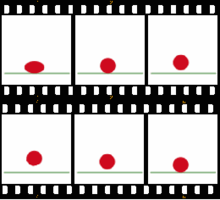
Back بوابة:رسوم متحركة Arabic دەروازە:ئەنیمەیشن CKB Portal:Animation German درگاه:پویانمایی Persian Portail:Animation French Portale:Animazione Italian Portal:アニメ Japanese 포털:애니메이션 Korean Portal:Animação Portuguese Портал:Мультипликация Russian

| Main | Categories and topics | Tasks and projects |
Introduction
Animation is a filmmaking technique by which still images are manipulated to create moving images. In traditional animation, images are drawn or painted by hand on transparent celluloid sheets (cels) to be photographed and exhibited on film. Animation has been recognized as an artistic medium, specifically within the entertainment industry. Many animations are computer animations made with computer-generated imagery (CGI). Stop motion animation, in particular claymation, has continued to exist alongside these other forms.
Animation is contrasted with live-action film, although the two do not exist in isolation. Many moviemakers have produced films that are a hybrid of the two. As CGI increasingly approximates photographic imagery, filmmakers can easily composite 3D animations into their film rather than using practical effects for showy visual effects (VFX). (Full article...)
Selected article
Little Nemo is a 1911 silent animated short film by American cartoonist Winsor McCay. One of the earliest animated films, it was McCay's first, and featured characters from McCay's comic strip Little Nemo in Slumberland. Its expressive character animation distinguished the film from the experiments of earlier animators. Inspired by flip books his son brought home, McCay came to see the potential of the animated film medium. He claimed to be the first to make such films, though James Stuart Blackton and Émile Cohl were among those who preceded him. The short's four thousand drawings on rice paper were shot at Vitagraph Studios under Blackton's supervision. Most of the film's running time is made up of a live-action sequence in which McCay bets his colleagues that he can make drawings that move. He wins the bet with four minutes of animation in which the Little Nemo characters perform, interact, and metamorphose to McCay's whim. Little Nemo debuted in movie theaters on April 8, 1911, and four days later McCay began using it as part of his vaudeville act. Its good reception motivated him to hand-color each of the animated frames of the originally black-and-white film. The film's success led McCay to devote more time to animation. He followed up Little Nemo with How a Mosquito Operates in 1912 and his best-known film, Gertie the Dinosaur, in 1914.
Selected image
Did you know (auto-generated) -

- ... that at age 12, Shaylee Mansfield became the first deaf actor to be credited alongside the voice actors for a signed performance in an animated production?
- ... that Raoul Servais invented a new technique for combining animation and live action for his short film Harpya?
- ... that the creators of the cartoon Jade Armor filmed live-action martial arts stunts to visualize the show's animated action sequences?
- ... that the first lady of the Ivory Coast created an animated kids' show in 1989?
- ... that Bruce Timm created most of the character designs for Batman: The Animated Series?
- ... that the stylized animation of Teenage Mutant Ninja Turtles: Mutant Mayhem was inspired by rough sketches in school notebooks?
Selected quote
Selected biography
Terence Vance "Terry" Gilliam (born 22 November 1940) is an American-born British screenwriter, film director, animator, actor and member of the Monty Python comedy troupe. Gilliam has directed 12 feature films, including Time Bandits (1981), Brazil (1985), The Adventures of Baron Munchausen (1988), The Fisher King (1991), 12 Monkeys (1995), and The Imaginarium of Doctor Parnassus (2009). The only "Python" not born in Britain, he became a naturalised British citizen in 1968. In 2006, he formally renounced his American citizenship.
Selected list
The list of episodes of Treehouse of Horror produced by the animated television series The Simpsons. Treehouse of Horror episodes have aired annually since the second season (1990) and each episode has three separate segments. These segments usually involve the family in some horror, science fiction, or supernatural setting and always take place outside the normal continuity of the show and are therefore considered to be non-canon. "Treehouse of Horror" episode aired on October 25, 1990 and was inspired by EC Comics Horror tales. Before "Treehouse of Horror XI", which aired in 2000, every episode has aired in the week preceding or on October 31; "Treehouse of Horror II" and "Treehouse of Horror X" are the only episodes to air on Halloween. For "Treehouse of Horror", there were even three different directors for the episode. However, starting with season fifteen's "Treehouse of Horror XIV", only one writer was credited as having written a Treehouse of Horror episode, and the trend has continued since.
More did you know...
- ...that comedy writer Al Jean (pictured), who has been awarded with four Emmy Awards for his work on The Simpsons, graduated from Harvard University with a bachelor's degree in mathematics?
- ...that The Old Lady and the Pigeons lost the Oscar but won the Genie?
- ...that to watch an early screening of "The Gathering", attendees of the Star Wars Celebration VI had to bring their kids with them?
Anniversaries for August 11
- Films released
- 1934 – Orphan's Benefit (United States)
- 1939 – Donald's Penguin (United States)
- 1943 – Defense Against Invasion (United States, commercial short)
- 1944 – Puppet Love (United States)
- 1945 – Hare Conditioned (United States)
- 1950 – Food for Feudin' (United States)
- 1950 – Popeye Makes a Movie (United States)
- 1951 – His Hare-Raising Tale (United States)
- 1995 – Runaway Brain (United States)
- Television series and specials
- 1991 – Doug, an American animated television series begins airing on Nickelodeon
- 1991 – Rugrats, an American animated television series (Hollywood Walk of Fame pictured) begins airing on Nickelodeon
- 1991 – The Ren & Stimpy Show, an American animated television series begins airing on Nickelodeon
Subportals
Related portals
Wikimedia
The following Wikimedia Foundation sister projects provide more on this subject:
-
Commons
Free media repository -
Wikibooks
Free textbooks and manuals -
Wikidata
Free knowledge base -
Wikinews
Free-content news -
Wikiquote
Collection of quotations -
Wikisource
Free-content library -
Wikiversity
Free learning tools -
Wiktionary
Dictionary and thesaurus
© MMXXIII Rich X Search. We shall prevail. All rights reserved. Rich X Search



























